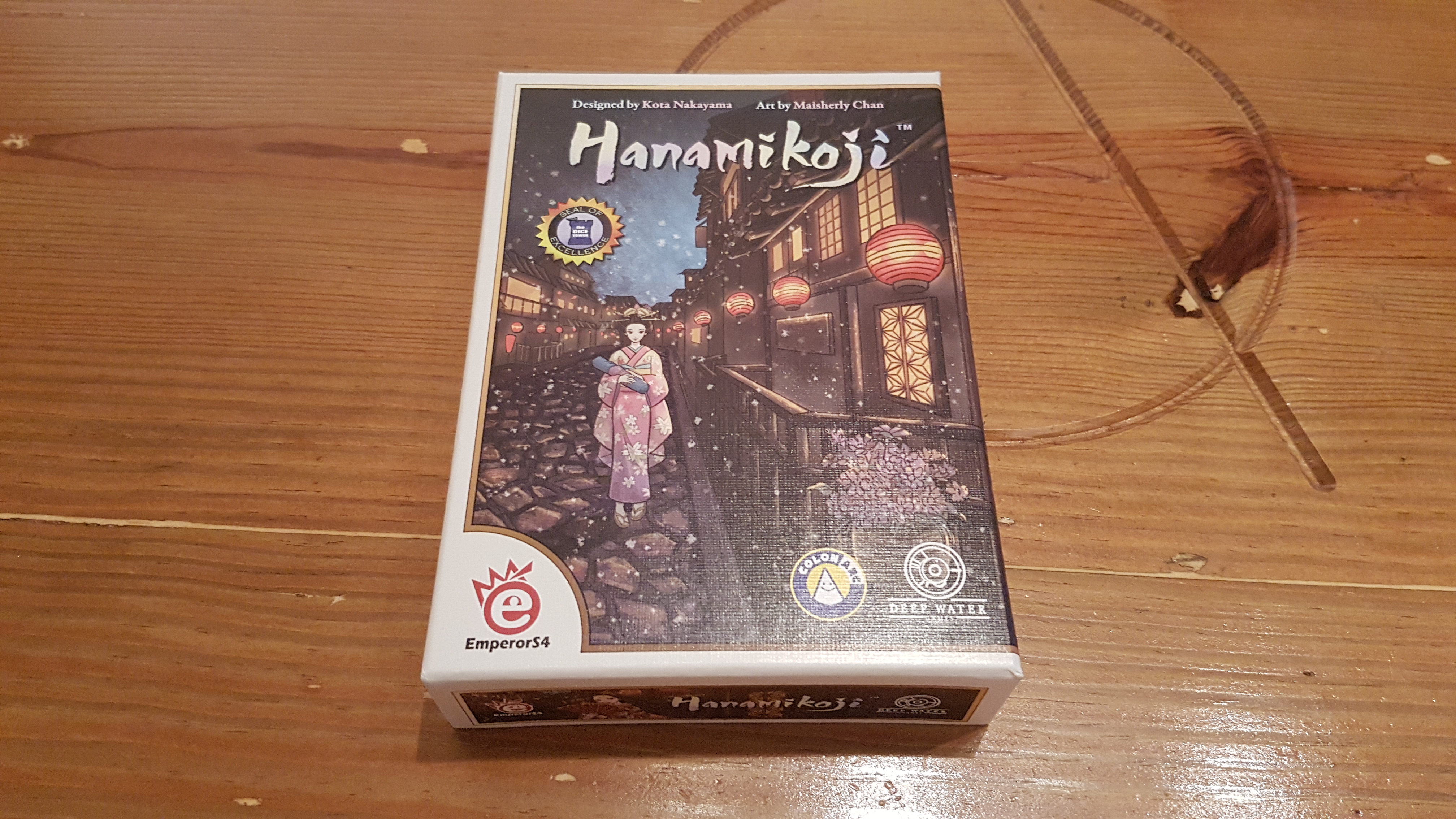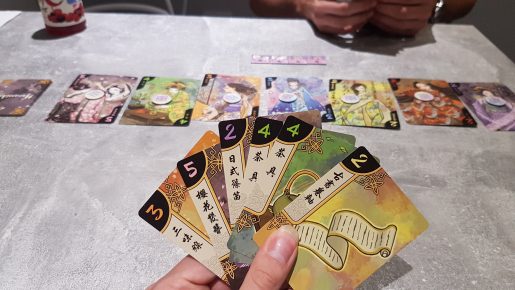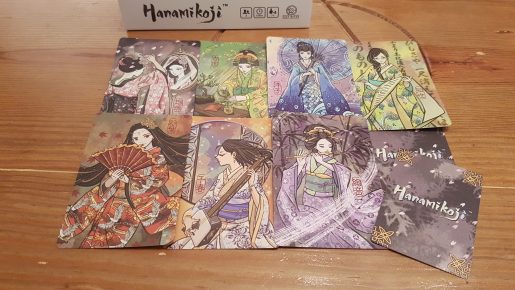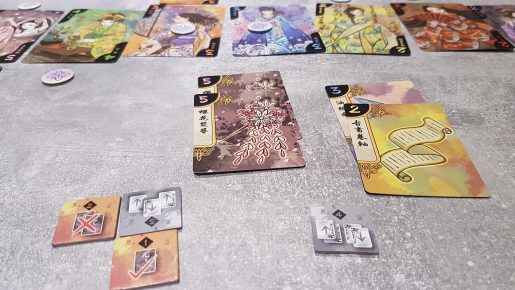Hanamikoji is a Japanese Geisha themed card game, from publisher EmperorS4 and designer Kota Nakayama. Released back in 2013, the game has recently been restocked by Asmodee UK, so we got to check out this 2 player title, that has a small footprint and short playtime – approximately lasting only 10 minutes. Throughout the short game, players must collect items related to music, dance and more to earn the favour of the Geishas. However, do the Geishas deserve your time? Let’s find out!
Quick to set up and play, to get Hanamikoji to the table the two players need only to lay out the 7 Geishas in the middle of the table, shuffle the item deck, grab their half of the action tokens and place the victory tokens on top of the Geishas. Geishas range in charm points from 2 to 5, with there being a heavier weighting to the lower end of the spectrum. The value indicates how many item cards of that type are in the deck, and are potentially significant for end of round scoring. After removing a single card from the deck, both players get dealt 6 cards. Starting with the youngest player, each turn has two small stages: draw a card and do an available action.
There are four actions, each (in order) using a card more than the last. Each can be taken once and only once in a round. Secret sees the player choosing a card from their hand and placing it facedown on the table – kept secret from their opponent until just before scoring. Discard is unsurprisingly a discard action, where the player must set two cards aside, that will not be included in scoring. Importantly, you can check what cards you’ve played for either secret and discard – just in case you forget.
Gift sees the active player place three cards face up on the table in front of themselves. Their opponent can then choose one to play against a Geisha on their side of the line-up, against the matching Geisha. Following this the active player gets to play the remaining two on their side of the line-up. The final action, competition, is similar but sees the active player place two sets of two cards faceup on the table. Their opponent gets to choose a pair to play on the line-up, with the active player playing the remaining pair.
Once each player has completed the four actions they will be perfectly out of cards. Starting with six, gaining 1 each turn (4 additional to total 10) and playing 10 over the course of the four actions. At this stage the secret card is revealed and added to the players side of the Geisha line-up before it is determined whom has won the favour of each individually. This is done by seeing whom has played the most of each item type. For any Geisha you have the most item cards for you claim the victory token by moving it to your side of the line-up, with draws seeing victory tokens remain where they are. If one player has gained the favour of four Geishas, or gained 11 or more charm points, they have won. If this hasn’t occurred the item cards are collected, shuffled and another round commences.
Note: the victory tokens are not reset, giving more importance to drawing item count wise on Geishas in round two.
For some reason drawing a card is a commonly missed part of the turn, perhaps due to players trying to constantly work with the information already available to them. While it is possible to count backwards, through turns, to make sure players draw up to the right amount of cards, it is a strange situation. Especially, when it should be as simple as a simple mentioned of saying “make sure you draw”. A couple of games in and this will start to fade away, though after this point and when a little too tired I still noticed it being occasionally forgotten.
There is nothing difficult about the four actions available to players, yet the order you choose to take them and the information you can ascertain from them is immense. They create gameplay that is simple when you first pick up the game, making sense within minutes of playing. At the same time, it grows with your experience. After only a couple of games the decisions seem to carry more weight to them, as the consequences become apparent.
Take the discard action as an example. In the first couple of games, I found the early logic was that the action was there to simply stop an opponent gaining cards that could help contest a Geisha you were after. Yet, just as impactful is the information you gain, and hide from your opponent, about what is then unavailable. Mostly, as it can help future decisions. Letting it be the last action, where you have no option of what to bury, allows you no chance to react – something that is key to earning enough Geishas’ favour.
There aren’t hundreds of components included in the box. 21 item cards, 7 Geisha cards, 8 action tokens, 7 victory tokens and a rulebook is the complete list. The favour tokens are nothing incredible, featuring a little pattern. The action tokens are well designed with simple iconography that represents each action, plus you can flip them over to a greyed out side once used, acting as a reminder. The cards are where the production value jumps, with some beautiful artwork of Geisha’s and the items that match them. The only issue with the stunning Geisha cards is that they may contribute to the box size.
The box size is a clear point of compromise from the publisher. The box is no doubt on the small side, which makes it very portable. Alas, it could be even smaller, perhaps a third of the size. It is a shame that games that are sold in a store need some shelf presence. This being said, if the box was the size of a normal pack of playing cards, realistically the size it could be if the Geisha cards were 10% smaller, it would be added to my travel list permanently – not just as a potential to be thrown in for train journeys or flights.
Overall, Hanamikoji is a wonderful 2 player title that despite having limited components and a limited footprint, does not provide only limited entertainment. Within minutes of getting the game to the table new players will be up to speed and veteran players will be strategically offering or discarding cards. Players always start off questioning how they can do all the actions with so few cards but this highlights how tight Hanamikoji’s design is – that the perfect number of cards is always available. Choice is always there for players and to make each decision feel so important in such a short game is more than impressive. If you’re looking for a short 2 player game look no further!
[Editor’s Note: Hanamikoji was provided to us by Asmodee UK for review purposes. The game is currently available on 365 Games for £16.99. It is also available from local UK board game stores, find your local store here]




